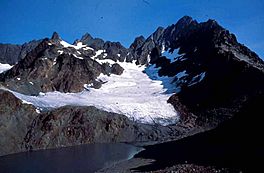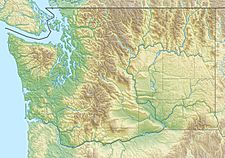Anderson Glacier facts for kids
Quick facts for kids Anderson Glacier |
|
|---|---|

Anderson Glacier, photographed by National Park Service, date unknown
|
|
| Type | Mountain glacier |
| Coordinates | 47°42′48″N 123°20′06″W / 47.71333°N 123.33500°W |
| Terminus | Proglacial lake |
| Status | Severe retreat/extinct |
Anderson Glacier was a glacier located in the Olympic Mountains in Washington, USA. It was found in Olympic National Park, south of Mount Anderson. This glacier was once a significant part of the landscape. Sadly, it has now almost completely disappeared due to climate change.
What Was Anderson Glacier?
Anderson Glacier was a large mass of ice that moved very slowly. It was located in a bowl-shaped area called a cirque. This cirque was on the south side of Mount Anderson. The glacier started high up on the mountain. It began at about 1,890 to 1,830 meters (6,200 to 6,000 feet) above sea level.
Where Was It Located?
The glacier was found in the Olympic Mountains. These mountains are part of Olympic National Park. This park is in Jefferson County, Washington, in the USA. The glacier flowed downwards to about 1,600 meters (5,240 feet) before it ended.
How Did It Change?
Meltwater from the glacier used to flow into a lake. This lake was about 1,508 meters (4,949 feet) high. From there, the water would tumble down a steep cliff.
Between 1927 and 2009, Anderson Glacier shrank a lot. It lost more than 90 percent of its surface area. By 2011, the glacier was almost completely gone.
Impact on the River
The disappearance of Anderson Glacier had an effect on the Quinault River. This river used to get a lot of its water from the melting glacier. Without the glacier's meltwater, the Quinault River has reached new low water levels.


